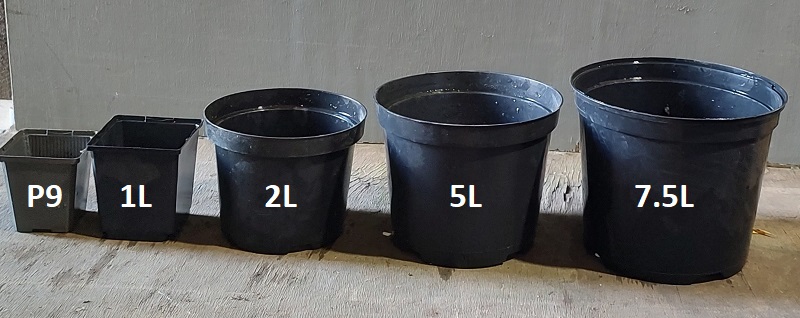Best Value Plants - Plant Pot Size Guide
The pot size you buy your plant in is critical to plant development and survival. It is very important to ensure that the plant(s) you are buying have been grown in the size of a pot that provides not just the cheapest plant but represents the best value for that particular plant. Some suppliers avoid ensuring pot size is clear at the point of purchase so their plants look inexpensive but in the long run, they can result in slower development and increased losses. Some offer plants in P9 pots which are plants often less than 1 year old, many varieties of which can be more difficult to establish straight out in the garden. Clearly, a plant in a 2 litre pot has twice the root system of one that initially may look slightly cheaper in a 1 litre pot but often offers worse value for money. Always check!

The majority of plants sold online by Jacksons Nurseries come in pots of various sizes. Most pot sizes are referred to by their volume capacity in litres, with the exception of pots that are smaller than 1 litre which is usually referred to by the diameter or cross section of the top of the pot (P9 is approximately a 9 x 9 cm pot).
The table below gives the approximate measurements of the common pot sizes we use at Jacksons Nurseries. Generally, for instance, grasses, shrubs, ferns & perennials etc are the best value in a 2 or 3 litre pot unless there is a particular cultural reason to grow in a larger pot. Sizes are only a guide as the exact measurements vary depending on pot manufacturers.
| Pot Size | Pot Diameter (Top) | Pot Diameter (Base) | Pot Height | |||
| 9cm | 9.0cm | 3.5" | 6.0cm | 2.5" | 8.5cm | 3" |
| 1 Litre | 13.0cm | 5" | 10.0cm | 4" | 11.0cm | 4" |
| 2 Litre | 17.0cm | 6.5" | 12cm | 4.5" | 13.0cm | 5" |
| 3 Litre | 19.0cm | 7.5" | 13cm | 5" | 15.0cm | 6" |
| 4 Litre | 20.0cm | 8" | 15.5cm | 6" | 16.5cm | 6.5" |
| 5 Litre | 22.5cm | 9" | 16.5cm | 6.5" | 18.0cm | 7" |
| 7 Litre | 25.0cm | 10" | 19.0cm | 7.5" | 20.0cm | 8" |
| 10 Litre | 28.0cm | 11" | 24.0cm | 9.5" | 22.5cm | 9" |
| 15 Litre | 33.0cm | 13" | 25.5cm | 10" | 30.0cm | 12" |
| 20 Litre | 35.5cm | 14" | 27.5cm | 11" | 32.5cm | 13" |
| 25 Litre | 38.5 cm | 15" | 30.0cm | 12" | 35.0cm | 14" |
| 30 Litre | 41.0cm | 16" | 33.0cm | 13" | 36.0cm | 14" |
| 40 Litre | 50.0cm | 20" | 35.5cm | 14" | 45.0cm | 18" |
So, always look out for the pot size the plant has been grown in – its critical best value for your garden and budget.
Share this page:

